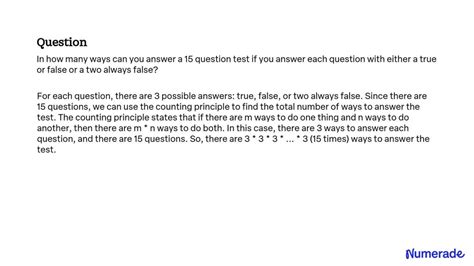In the midst of a hectic academic schedule, the looming presence of a 15-question test can incite a surge of anxiety. However, with a well-structured preparation plan and effective time management, you can confidently tackle this exam and achieve your desired score.

Effective Strategies for a 15-Question Test
1. Review the Syllabus and Course Materials:
Thoroughly review the syllabus and course materials to identify the key concepts and topics that will be covered on the test. This will help you focus your preparation efforts.
2. Practice with Sample Questions:
If possible, obtain sample questions or practice tests from the instructor or online resources. Solving these questions will give you firsthand experience with the format and difficulty level of the actual exam.
3. Create a Study Plan:
Break down the material into smaller chunks and create a study plan that allocates specific time slots for each topic. This will help you prioritize your time and ensure you cover all the necessary concepts.
4. Utilize Highlighting and Note-taking:
As you review the course materials, highlight important information and take notes. This will create a condensed version of the material for quick reference during your last-minute cram session.
5. Active Recall:
Instead of passively reading the material, actively recall and test yourself on the key concepts. This can be done by using flashcards, self-quizzes, or explaining the material to a study partner.
Time Management Tips and Tricks
1. Pomodoro Technique:
To improve your focus and productivity, try the Pomodoro technique. It involves alternating between 25-minute study periods and 5-minute breaks.
2. Chunk Down Questions:
If the test includes multiple-choice questions, chunk down the options into smaller groups and eliminate the ones that are clearly incorrect. This will reduce the number of choices you have to consider.
3. Time Allocation:
Estimate the amount of time you will need for each question and allocate your time accordingly. Don’t spend too much time on any one question, as it could lead to running out of time.
Pros and Cons of Different Question Types
| Question Type | Pros | Cons |
|---|---|---|
| Multiple Choice | Quick and easy to answer | Can be misleading or ambiguous |
| True/False | Straightforward | May be trick questions |
| Fill-in-the-Blank | Tests specific knowledge | Can be difficult to remember exact details |
| Essay | Provides a chance to demonstrate in-depth understanding | Time-consuming to write |
Creative New Word: “Quizzovate”
To generate ideas for new applications that utilize the concept of a 15-question test, consider the word “quizzovate,” which combines “quiz” and “innovate.” This can lead to innovative ideas such as interactive learning games, adaptive testing platforms, or collaborative quiz-based experiences.
Useful Tables
| Test-Taking Strategy | Key Points | Example |
|---|---|---|
| Chunking Down | Break down questions into smaller groups | Eliminate incorrect options in multiple-choice questions |
| Active Recall | Test yourself on key concepts | Use flashcards or self-quizzes |
| Time Allocation | Estimate time per question | Plan to finish the exam with time to spare |
| Quizzovation | Generate innovative quiz-based applications | Interactive learning games, adaptive testing |
Conclusion
Preparing for a 15-question test requires a systematic approach and effective time management strategies. By following the tips and tricks outlined in this article, you can develop a comprehensive preparation plan that will optimize your retention, boost your confidence, and ultimately lead to a successful outcome on test day. Remember, with the right preparation and mindset, you can conquer any exam, no matter the number of questions.
